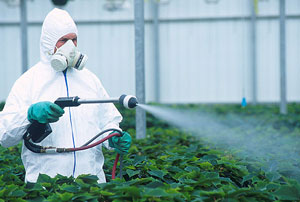 For a few decades now, major employers across the United States have focused on providing wellness programs that encourage employees to adopt healthy lifestyle habits, such as nutritional eating, exercise and smoking cessation. This is based on the premise that a healthy workforce will be more productive, and ultimately will help reduce health insurance costs. [Read more…]
For a few decades now, major employers across the United States have focused on providing wellness programs that encourage employees to adopt healthy lifestyle habits, such as nutritional eating, exercise and smoking cessation. This is based on the premise that a healthy workforce will be more productive, and ultimately will help reduce health insurance costs. [Read more…]
Is your workplace making you sick?
New evidence: A link between air pollution and stroke
 We’ve had clear evidence for decades that air pollution is bad for your health, specifically your lungs and heart. The data show air pollution increases your risk of asthma, COPD and pneumonia. But a new systematic review unveils another serious risk: stroke. [Read more…]
We’ve had clear evidence for decades that air pollution is bad for your health, specifically your lungs and heart. The data show air pollution increases your risk of asthma, COPD and pneumonia. But a new systematic review unveils another serious risk: stroke. [Read more…]
Growing evidence: Environmental factors influence heart disease
 In the United States, we regularly hear messages about how to prevent heart disease. Eat more vegetables. Exercise more. Avoid fatty meats. But there is a large and growing body of evidence that demonstrates the environment also impacts our risk of developing cardiovascular disease. [Read more…]
In the United States, we regularly hear messages about how to prevent heart disease. Eat more vegetables. Exercise more. Avoid fatty meats. But there is a large and growing body of evidence that demonstrates the environment also impacts our risk of developing cardiovascular disease. [Read more…]
Gardening as a treatment for dementia
 Researchers believe nearly 4 million Americans over age 60 suffer from some form of dementia. Their symptoms may include memory loss, impaired judgment and reasoning, loss of communication skills, agitation and paranoia. [Read more…]
Researchers believe nearly 4 million Americans over age 60 suffer from some form of dementia. Their symptoms may include memory loss, impaired judgment and reasoning, loss of communication skills, agitation and paranoia. [Read more…]
The evidence on climate change
 The theory that the earth’s climate is warming has been a highly debated topic in the media for more than a decade. Proponents of the theory point to evidence about melting polar ice caps and increased storm activity, while critics say there’s not enough data to know what’s happening over the long-term. But what does the evidence really say?
The theory that the earth’s climate is warming has been a highly debated topic in the media for more than a decade. Proponents of the theory point to evidence about melting polar ice caps and increased storm activity, while critics say there’s not enough data to know what’s happening over the long-term. But what does the evidence really say?
Are mammograms worthwhile?
 The National Cancer Institute recommends that women age 40 and older have a mammogram to screen for breast cancer every 1 or 2 years. But now a new study is raising questions about whether mammography is really worthwhile. [Read more…]
The National Cancer Institute recommends that women age 40 and older have a mammogram to screen for breast cancer every 1 or 2 years. But now a new study is raising questions about whether mammography is really worthwhile. [Read more…]
Update: New evidence on Parkinson’s disease
 According to the National Institutes of Health, at least 500,000 Americans suffer from Parkinson’s disease, and about 50,000 new cases are reported each year. The disease is a progressive neurological disorder that is caused by the degeneration of neurons in a region of the brain that controls movement. Tremors are the most common symptom, but others include rigid limbs and slow movement. [Read more…]
According to the National Institutes of Health, at least 500,000 Americans suffer from Parkinson’s disease, and about 50,000 new cases are reported each year. The disease is a progressive neurological disorder that is caused by the degeneration of neurons in a region of the brain that controls movement. Tremors are the most common symptom, but others include rigid limbs and slow movement. [Read more…]
Evidence on child well-being across the globe
 Ensuring children grow up to be healthy, productive and fulfilled adults are major goals of every society. Children across the world today face complex risks and challenges including the wide availability of unhealthy foods, the prevalence of bullying and increases in drug and alcohol abuse. [Read more…]
Ensuring children grow up to be healthy, productive and fulfilled adults are major goals of every society. Children across the world today face complex risks and challenges including the wide availability of unhealthy foods, the prevalence of bullying and increases in drug and alcohol abuse. [Read more…]
The facts on mold for hurricane victims
 Nearly a month after hurricane Sandy battered the east coast, homeowners in New York and New Jersey are still trying to dry out their homes and assess all of the damage. For those whose homes were flooded, a major problem they will face is mold.
Nearly a month after hurricane Sandy battered the east coast, homeowners in New York and New Jersey are still trying to dry out their homes and assess all of the damage. For those whose homes were flooded, a major problem they will face is mold.
Mold spores thrive in flooded homes, where everything is damp and there is plenty of organic material as a base for them to grow and thrive. They often cause respiratory problems, irritate the skin and eyes, and can lead to lung infections.
Here at EBL, the topic of mold in homes is not a new one. Just last year, we wrote about a systematic review by the Cochrane Collaboration that details the best ways to prevent respiratory problems caused by mold.
Luckily, there is plenty of solid evidence on effective ways to cope with mold in your home. Joe Laquatra, a professor of design and environmental analysis at Cornell, is an expert in coping with mold in homes and a member of the New York State Center for Indoor Environmental Quality. He has developed a comprehensive, evidence-based information sheet that details the health effects of mold in homes and the best methods for removing it.
Among his recommendations are:
- Homes that are wet for more than 48 hours are at risk of developing mold.
- It’s best to discard wet ceiling tiles, cellulose insulation, and often drywall as well.
- If mold is detected over more than ten square feet of a home, the best course of action is to hire a mold remediation contractor. Another fact sheet offers tips about selecting a contractor.
The take-home message: Mold is a serious issue in homes that have experienced flooding. It’s important to understand all of the facts to avoid health problems caused by mold.
To spray or not to spray?
Lyme disease – an infectious disease spread by ticks that thrive in wooded areas – is on the rise in the Northeast. The disease can be debilitating if undiagnosed, causing chronic fatigue, joint pain and neurological problems.
neurological problems.
As a mom, it’s a really worry for me. My kids are outside every day, often on trails or in wooded areas. I check them daily for ticks, but one would be easy to miss.
This year, I’ve often debated with other parents the risk and benefits of using bug spray. On one hand, there is clear evidence that the insecticide DEET – or N,N-diethyl-meta-toluamide – effectively repels ticks. But on the other hand, there are cases where it is clear that DEET has led to health problems including skin problems, hallucinations and seizures.
So I went hunting for some more sweeping analyses on what the evidence says about DEET. The Journal of Family Practice provided a good summary of several systematic reviews on the use of DEET in children. Both found the risk of adverse reactions was low – about 0.1 percent of children exposed experiences an adverse reaction – and that there was no clear dose-dependent relationship between exposure and extent of severity of the reaction.
The U.S. Centers for Disease Control maintains that DEET doesn’t present health concerns if it’s used according to the instructions, including not applying it to open wounds, under clothing, or near eyes or mouth.
As a mother, though, the narrative reports of small children undergoing hospitalization for seizures and neurological problems – even though it’s a very small number of cases over decades – stick in my mind. So we use bug spray with DEET sparingly. If I know the kids will be in the woods or fields where there are higher populations of ticks, I’ll give them a light spray – always with a bath that night to wash off all of the spray. Even though the evidence shows DEET is safe, I still feel uneasy about this issue.
What about you? Are you comfortable using buy spray on a regular basis?




